Post-Traumatic Urbanism
Cities like Mumbai and Beirut have developed in unstable uncertainty and in many ways are resilient survivors. They have adapted with 'redundant networks' and 'diversity and distribution' rather than 'centralized efficiency' which makes them flexible in the face of shocks to infrastructure (Lahoud, 2010).
Mumbai as a city has undergone several traumatic events in the past few years. Those in my direct memory and experience are the 26/11 attacks and the painfully recent 2011 bombings. Earlier I argued that despite these tragic events the city in essence remained the same. How does a city survive these traumatic events whether they are natural flash floods or terror attacks, and in what way does it change? Today people try to understand how cities survive and evolve through math and science. As a philosophy urbanism states that cities are vitally important to the progress of humanity. In his talk The Surprising Math of Cities and Corporations, West argues that cities are both the solution and the problem, underlining their bipolarity.
And the tsunami of problems that we feel we're facing in terms of sustainability questions, are actually a reflection of the exponential increase in urbanization across the planet... However, cities,despite having this negative aspect to them, are also the solution. Because cities are the vacuum cleaners and the magnets that have sucked up creative people, creating ideas, innovation, wealth and so on. So we have this kind of dual nature. (Geoffrey West, 2011)
West explains why cities are so successful when he says 'You could drop an atom bomb on a city, and 30 years later it's surviving. Very few cities fail.' Mumbai as a city has survived several traumatic events over the past two hundred years, though nothing on such a catastrophic level. It is an ancient place that has been ruled by a succession of invaders. There is even evidence that suggest that the islands have been colonized by humans since the Stone Age. Each event in this recorded and unrecorded past have changed the landscape and its people, but I am most interested in its recent traumas.
So cities are extremely successful, bipolar creatures. But how do traumas affect them? Philosopher and critical theorist Andrew Benjamin says that 'trauma involves a more complex sense of place.' He proposes that the city contains forgotten and repressed settings that are beyond memory but always present, creating an 'estrangement' and sense of the 'unaccustomed' when such events return.
The term 'post-traumatic' refers to the evidence of the aftermath - the remains of an event that are missing. The spaces around this blind spot record the impression of the event like a scar. (Lahoud, 2010. p.19).
Cities like Mumbai and Beirut have developed in unstable uncertainty and in many ways are resilient survivors. They have adapted with 'redundant networks' and 'diversity and distribution' rather than 'centralized efficiency' which makes them flexible in the face of shocks to infrastructure (Lahoud, 2010). When it comes to events like the most recent bomb attack in 2011, the city picked up the pieces and went on the next day as if nothing had happened. Local trains continued to run. The event was given its significant narrative by the media and the places that were bombed were cleared up. Memories and the gaps created by such violence will always remain an intrinsic part of the city's architecture. But it is Mumbai's impenetrable resilience in the face of such catastrophes that fascinates me. Events such as 9/11 in a first world country completely derailed the city, but in Mumbai it was in many ways business as usual. But forgetting like we do in Mumbai does not erase the hurt.
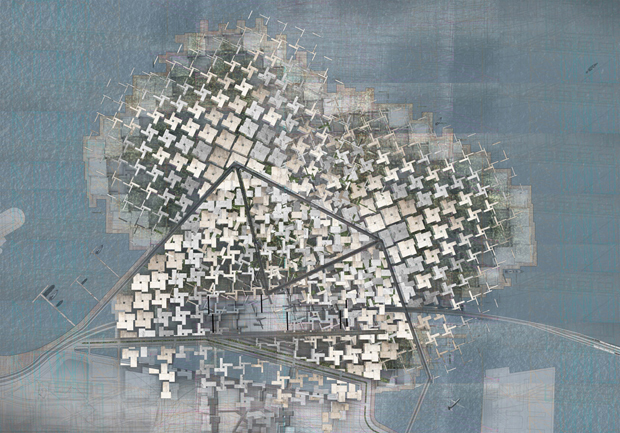 The Diversity Machine and Resilient Network, 2009. Social Transformation Studio. Martin abbot, Georgia Abbot, Clare Johnston, Joshua Lynch and Alexandra Wright.
The Diversity Machine and Resilient Network, 2009. Social Transformation Studio. Martin abbot, Georgia Abbot, Clare Johnston, Joshua Lynch and Alexandra Wright.
Anthony Burke says that the reason cities are so difficult to predict is that they are very complex systems 'growing at the edge of chaos.' Even small events can lead to avalanche-like conditions because both natural and human-made catastrophes display a self-organizing criticality or the:
...tendency of large systems with many components to evolve into a poised, `critical' state, way out of balance, where minor disturbances may lead to events, called avalanches, of all sizes. Most of the changes take place through catastrophic events rather than by following a smooth gradual path. The evolution to this very delicate state occurs without design from any outside agent. The state is established solely because of the dynamical interactions among individual elements of the system: the critical state is self-organized. Self-organized criticality is so far the only known general mechanism to generate complexity. (Per Bak, 1997, p.1).
The idea that a city is on the verge of chaos is not far from many narratives in western popular culture. The accepted line is that just one push is enough to bring the whole system crumbling down. However the theory above is not as simple as that, these systems are large and therefore extremely difficult to destroy completely. Its heartening to see that even human cities are in the end, part of nature, and follow patterns similar to natural phenomenon such as weather.
Although there are no definitive answers to what post-traumatic urbanism is the term itself raises critical questions and discussion. An often quoted statistic today is that the urban world is larger than the rural world, which underlines the importance of trying to understand urban trauma and its effect on the city and its people. In my journey to capture the essence of Mumbai, to explore unexpressed feelings of conflict created by repressed events and resolve my own perceptions and experience; it is this complexity which is central to understanding my art.
Reference: Benjamin, A. (2010). Trauma within the Walls: Notes towards a philosophy of the city. Architectural Design. Vol. 80. No.5. pp.24-31. Burke, A. (2010). The Urban Complex: Scalar probabilities and Urban Computation. Architectural Design. Vol. 80. No.5. pp.87-91. Lahoud, A. (2010). Post Traumatic Urbanism. Architectural Design. Vol. 80. No.5. pp.14-23. Per Bak. (1996). How Nature Works: The Science of Self-Organised Criticality. Copernicus Press: New York. West, G. (2011). The Surprising Math of Cities and Corporations. [online]. Available from http://www.ted.com/talks/geoffrey_west_the_surprising_math_of_cities_and_corporations.html [Accessed 2nd Aug. 2011].
Site-Specific Art
In his book Eyes of the Skin, Pallasmaa talks at great length about the beauty of human perception and how the senses interact with each other to form experience. He emphasizes the importance of a sense experience as a whole. He says there is a bias to the eye in the architectural practice because people are focussed on how a building looks rather than how a body can move within it or how it feels. When it comes to the perception of places he discusses the importance of emotion, memory, imagination and fantasy.
During my research into place-making in phase two I briefly discussed the rigidity of a panoramic city view and my attempts to break it by framing unfamiliar cityscapes, using shadows and through collaboration. The book is relevant to my studies because it discusses creating place, the transitive nature of site, framing and virtual and 'real' spaces. The author describes monuments as loci's of power and authority (Kaye, 2000) in his chapter on Performing the City. This underlines the rigidity of the panorama since monuments are an iconic part of them. A relevant example is Mumbai's famous Nariman Point which is named after a historical Congress party leader and contains Indian and international financial institutions and government buildings such as CBI, RBI, Mittals, Birla's, JP Morgan, Merrill Lynch, Vidhan Sabha etc.
Monumentality […] always embodies and imposes a clearly intelligible message. It says what it wishes to say - yet it hides a good deal more: being political, military and ultimately fascist in character" (Lefebvre, 1991 cited in Kaye, 2000, p. 34).
He also discusses the relation between the body and the city or built environment and the body and the space, which in this case is the installation space in artist Wodiczko's work. A completely artificial and constructed installation is also a built environment. People interact with the architecture of the city, and similarly the audience interacts with the architecture of installation. The artist says that 'Our position in society is structured through bodily experience with architecture' (Wodiczko, 1992 cited in Kaye, 2000, p. 38).
In the installation test below, the audience directly affects an abstracted view of the city. In this constructed space people can directly change and affect an image of the architecture, making it fluid and interchangeable.
The author says 'where the site functions as a text perpetually in the process of being written and being read, then the site-specific work's very attempt to establish its place will be subject to the process of slippage, deferral and indeterminacy in which its signs are constituted' (Kaye, 2000, p. 183).
Further reading lead me to Merleau-Ponty's theories of phenomenology and perception where he discusses the essence of perception and experience. He says that we cannot separate our minds and bodies from our perception of the world, or in other words that we are 'condemned to meaning' (Merleau-Ponty, 1962, p. xxii). In his book the Phenomenology of Perception he discusses the relationship between reflective and unreflective experience, psychological and physiological aspects of perception, and consciousness as a process that includes feeling and reasoning.
We must not, therefore, wonder whether we really perceive a world, we must instead say: the world is what we perceive. (Merleau-Ponty, 1962, xviii).
In his book Eyes of the Skin, Pallasmaa talks at great length about the beauty of human perception and how the senses interact with each other to form experience. He emphasizes the importance of a sense experience as a whole. He says there is a bias to the eye in the architectural practice because people are focussed on how a building looks rather than how a body can move within it or how it feels. When it comes to the perception of places he discusses the importance of emotion, memory, imagination and fantasy:
We have an innate capacity for remembering and imagining places. Perception, memory and imagination are in constant interaction; the domain of presence fuses into images of memory and fantasy. We keep constructing an immense city of evocation and remembrance, and all the cities we have visited are precincts in this metropolis of the mind. (Pallasmaa, 2005, p.67).
In my attempts to create a feeling of conflict within the city, a subtle realization of the bipolarity within Mumbai, the result was a space that could not be expressed as a still image. Not could it be expressed by only video. By adding a third dimension of time and motion, where the audience themselves make the image change and break the city is read as something in constant flux.
I know myself only in my inherence in time and in the world, that is, I know myself only in ambiguity. (Merleau-Ponty, 1962, p.402).
Reference: Kaye, N. 2000. Site-Specific Art: Performance, Place and Documentation. Routledge: London Merleau-Ponty. 1962. Phenomenology of Perception. Routledge: London. Pallasmaa, J. (2005). Eyes of the Skin: Architecture and the Senses. John Wiley & Sons: UK. View Wodiczko's Bio & Work in detail.
Installations & Inspiration
Gerry Judah Paintings.
Fire with Fire (2010) by Isabelle Hayeur 3 channels video installation. Video projection of 15 minutes playing in continuous loop. 3 Blu-ray players, 3 video projectors. 112 West Hastings Street, Vancouver. Fire with Fire has been commissioned by The Vancouver 2010 Cultural Olympiad. Curator : Marlene Madison.
Rosa Barbara at Tate Modern. Article about the work here.
Show Homes and Display Desire (2007) by Vesna Pavlović. "Within the “Display, Desire” installation, the prints simultaneously function as images of display and display of images. Strange details of the American home are exposed, through the language of cinema and mechanisms of projection. The projection of black and white transparencies onto semi-transparent Plexiglas screens suggest the plastic quality of the interiors, and within the overlapping projection spaces, the images transform, exploring possible representations of the photographic medium itself."
Art Direction & Visuals: Deniz Kader – Candaş Şişman, Music & Sound Design: Görkem Şen, Project Management: Erdem Dilbaz, Modelling: Gökhan Uzun – Can Dinlenmiş (prospektif.org)
JR's (French Street Artist) TED Prize Wish: Use Art to turn the world Inside Out.
Place-Making
Notes on urban memory, place-making and its relation to the interpretation of the city in contemporary art and architecture.
During my tutorial with Ronnie Inglis we spoke about the meaning behind the autobiographical trend in my work and further topics of study, especially in relation to place-making. We discussed my previous areas of interest such as the city and fantasy, collective versus personal urban memories, place-making in relation to site-specific art, use of the shadow, and representing extremes. He directed me towards the book History of the Shadow which greatly influenced my work in the following weeks. The topic of Genius loci is relevant because I am interested in shooting my projections in outdoor locations. According to Thompson (2003, p.67) 'the Romans believed that places, like people, had inner spirits that determined their essences,' and similarly I was interested in this essence of Mumbai. Thompson also mentions that for genius loci to be useful rather than a mere magical notion it should be a combination of 'character, local distinctiveness and ecosystem' (2003, p.69). This lead to the idea of representing the city as a fictionalized creation, in the same way a writer creates a fictional character.
And a thing's character changes and develops over time. This can happen slowly or through abrupt events. The reading made me realize that Mumbai has not developed slowly or without trauma. It has grown in bursts and starts. Several traumatic events such as the '93 bombings and the more recent 26/11 Taliban attack have affected the city. We could argue however, that despite these severe shocks the essence of the city remains the same. According to Norberg-Schulz (cited in Thompson, 2003, p.70) "places can change, sometimes rapidly, but this does not necessarily mean that the genius loci changes or gets lost."
An excellent example of the genius loci being kept intact by an architect is the above landscape park Landschaftspark Duisburg-Nord by Peter Latz. The place was 'traumatized by industrialization and deindustrialization' and the architect built upon 'its existing character, creating fern gardens in ore bunkers and making their mass concrete walls into facilities for rock climbers' (Thompson, 2003, p.72). This connects to my idea of using appropriate objects, materials and sites that are relevant to the trauma and violence of the city.
^Cotton 56, Polyester 84 is a play about how the failed Mumbai Mills are getting converted into malls and entertainment complexes. Citizen's groups demand that the land should be converted into open parks and low cost housing, but slowly and surely all mill land will be sold to builders (Shanbag, 2006).
^Another abandoned Mumbai Mill.
As sites these are beautiful and tragic places that express this violent and crushing conflict between the here and the elsewhere, the undesirable and the desired. I can only pursue this direction further once I am back in India. At the same time it brings me to question my interest in these places, since my knowledge of these events is purely historical, through media reports and local people's opinions. At this point in my practice I would prefer to express issues and places that I have personally and directly experienced.
Another important aspect of place is memory, which is in turn closely related to history. Historical buildings such as the mills compounds and their replacements are part of a general history of the city. Individual memories have a completely different flavour. In the book City of Collective Memory the author underlines this difference by proposing that history and memory are bipolar attributes because history is linear and memory non-linear (Boyer, 2001, p.67). Collective memory is 'a current of continuous thought still moving in the present, still part of a group's active life, and these memories are multiple and dispersed, spectacular and ephemeral, not recollected and written down in one unified story' (Boyer, p.67).
Another fascinating point is that this urban memory is 'an antimuseum and not localizable' (Boyer, p.68). This means that my earlier work using popular landscapes and landmarks was a reference to history, a revision of a recognizable historical reality. It is also a reference to memory since I have taken various historical elements and placed them in a contemporary context. Now that I am using scenes that are not famous or instantly recognizable such as the Thane landscape I am removing "historical" elements from the work.
The next topic is framing. We frame the place or city 'by travel, in the theater, at the museum, from the cinema, through its architectural compositions' (Boyer, p.70). The panorama as a framed image is questionable - the city of the panorama is criticized for its 'rational scientific methods,' 'describable pasts' and 'predictable futures' (Boyer, p.68). The author criticizes common recycled views of the city saying 'We have learned to gaze upon the city as artifact through illustrated portfolios and architectural guidebooks that have their own procedures for characterizing place and tradition' (Boyer, p.69).
And finally I'll quote Victor Burgin (1996, p.7) who says that 'we cannot know a 'city', only those of its places we come to frequent.'
Reference
Boyer, C (2001). The City of Collective Memory, Its Historical Imagery and Architectural Entertainments. MIT Press.
Burgin, V. (1996). Some Cities. London: Reaktion Books Ltd.
Thompson, I. (2003). What use is the genius loci? In: Menin, S.(eds). Constructing Place, Mind and Matter. London: Routledge. pp.66-76.
Pile, S. and Thrift, N. (2000). City A-Z. London: Routledge
Wikipedia. (2011). Urbanism [online] Available from http://en.wikipedia.org/wiki/Urbanism. [Accessed 23rd April 2011].
Mini-Wada
The museum in Vishrambagwada is temporarily closed due to restoration work, but I managed to look at a few exhibits. The courtyard was littered with exhibits: models of famous wada's and historical buildings from Pune's history. It's ironic that these tiny models with cheap plastic figures are stored inside an actual wada, which by contrast is beautiful and original.

See more posts on Pune.
Found Art: Entrance/Door
There are a lot of old Tamil and French houses in Pondicherry. Some of the houses have an interesting fusion of Tamil and french architecture. For example, one house I had lived in for about two weeks when I first landed up in Pondy has a ground floor in Tamil style, with a large central courtyard et al, and the first floor in French style with a ballroom to entertain French guests. It was owned by an Indian beurocrat in the days when Pondy was a French Colony. A lot of these houses are in the prime areas right next to the beach. They are taken up and redone as guesthouses and cafe's and restaurants, and they flourish because of all the tourists coming in, or at least, I think they flourish. Anyway, this is a photograph of one such place. This beautiful house has been bought up by a kitchen company!
It was weird, we were walking by and from the outside, we thought it was probably a cafe so we walked in. Instead, its been converted into a store to sell kitchen appliances. It was strange and uncomfortable for some reason, the mismatch between the old house and the commercial kitchen company.
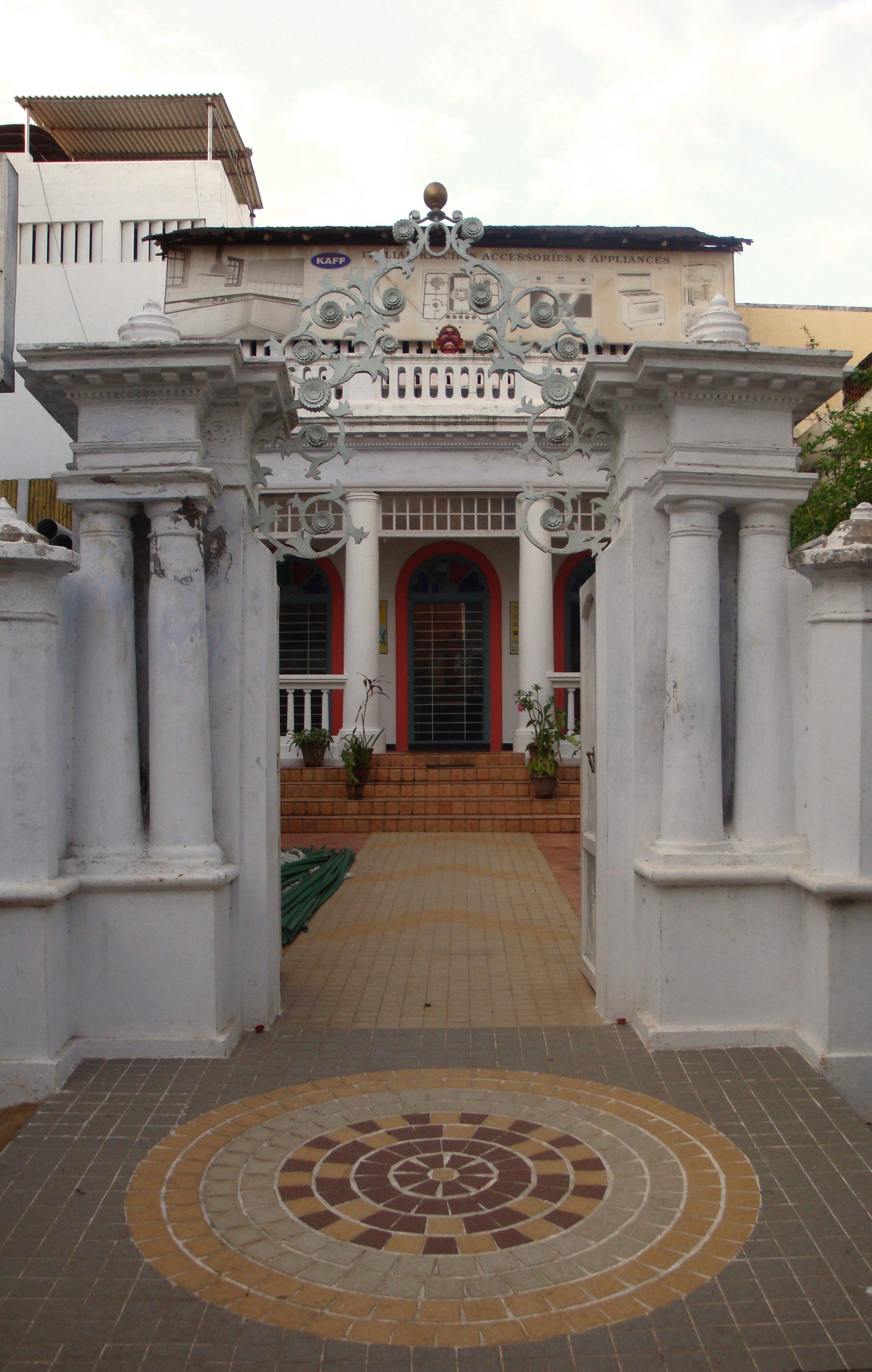
Detail: A beautiful door knob at the entrance -
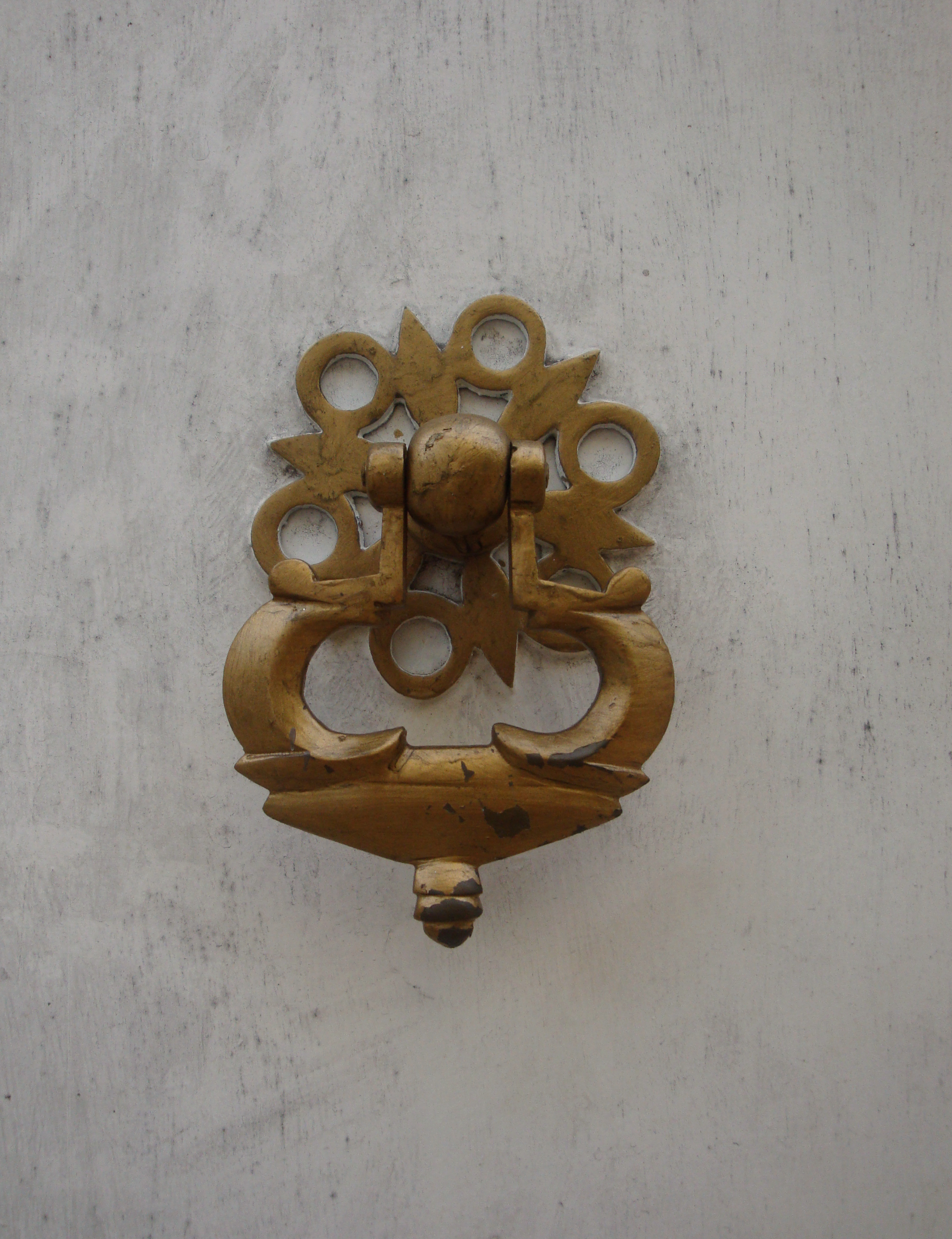
Tamil and French Fusion Architecture
I lived all alone in this old Tamil house for about two weeks while I was looking out for an apartment. Everyone told me it was haunted and all that, but I didn't have any scary experiences (what a surprise ^_^). The house itself was old, old and beautiful. The current owner told me an interesting story about the house. Less than a hundred years ago it was owned by a hi-flying Tamil bureaucrat when Pondicherry was still a French Colony. According to an old cook who has worked in the house for more than sixty years, the name of the previous owner was Ramaswami Chettiyar, his daughters name was Rani and his wife's name was Maragadham. He built the ground floor in traditional Tamil style, with a courtyard and everything, while the first floor is built in French style, with chandeliers, high ceilings and a huge ballroom to entertain French guests. I lived on the first floor, but most of the rooms were closed off. Large parts of the house have been broken down over time to give space for roads and neighbours, only the smaller parts of it remain, and even those are badly maintained. That's probably why some people find it scary.
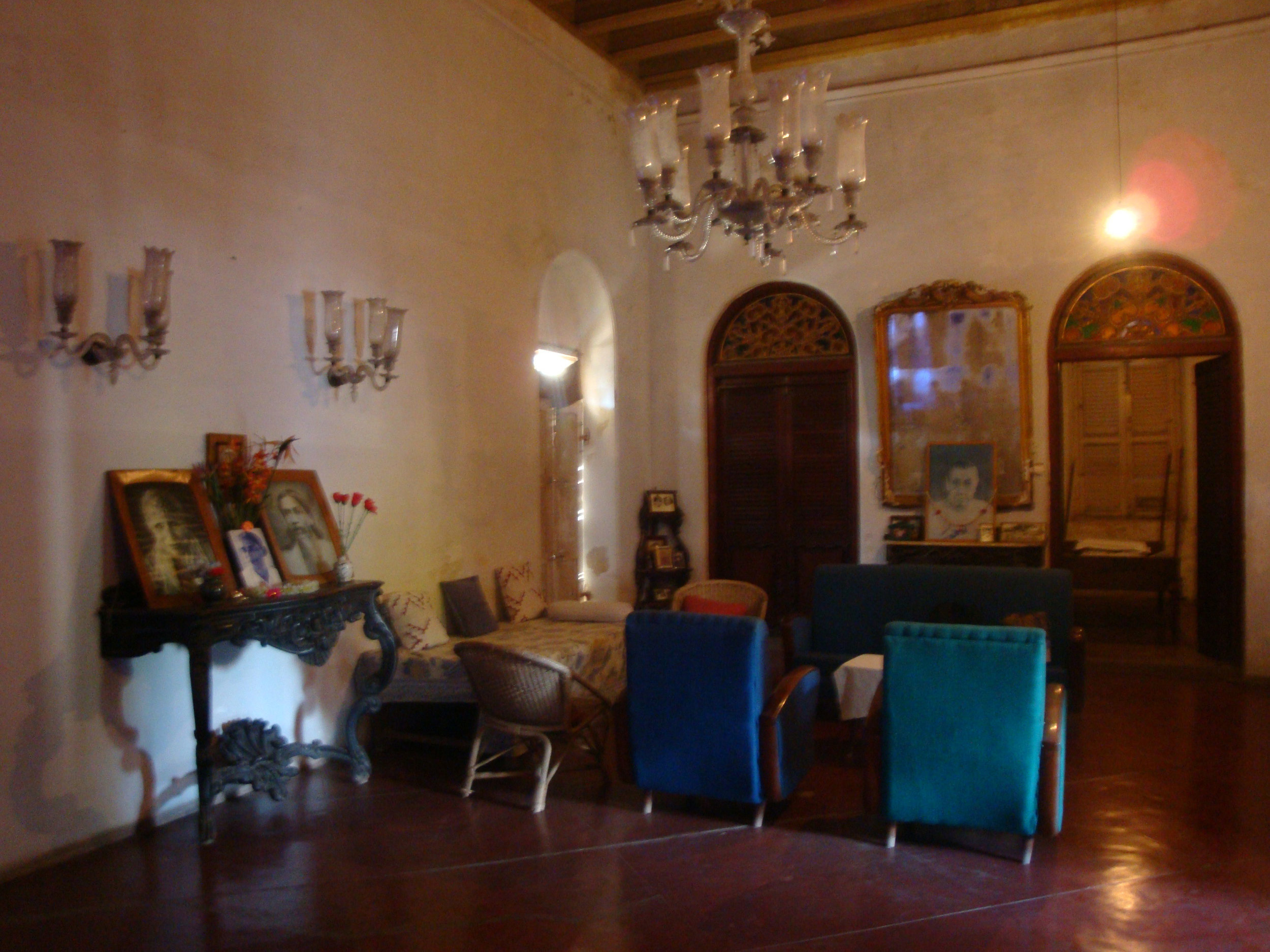
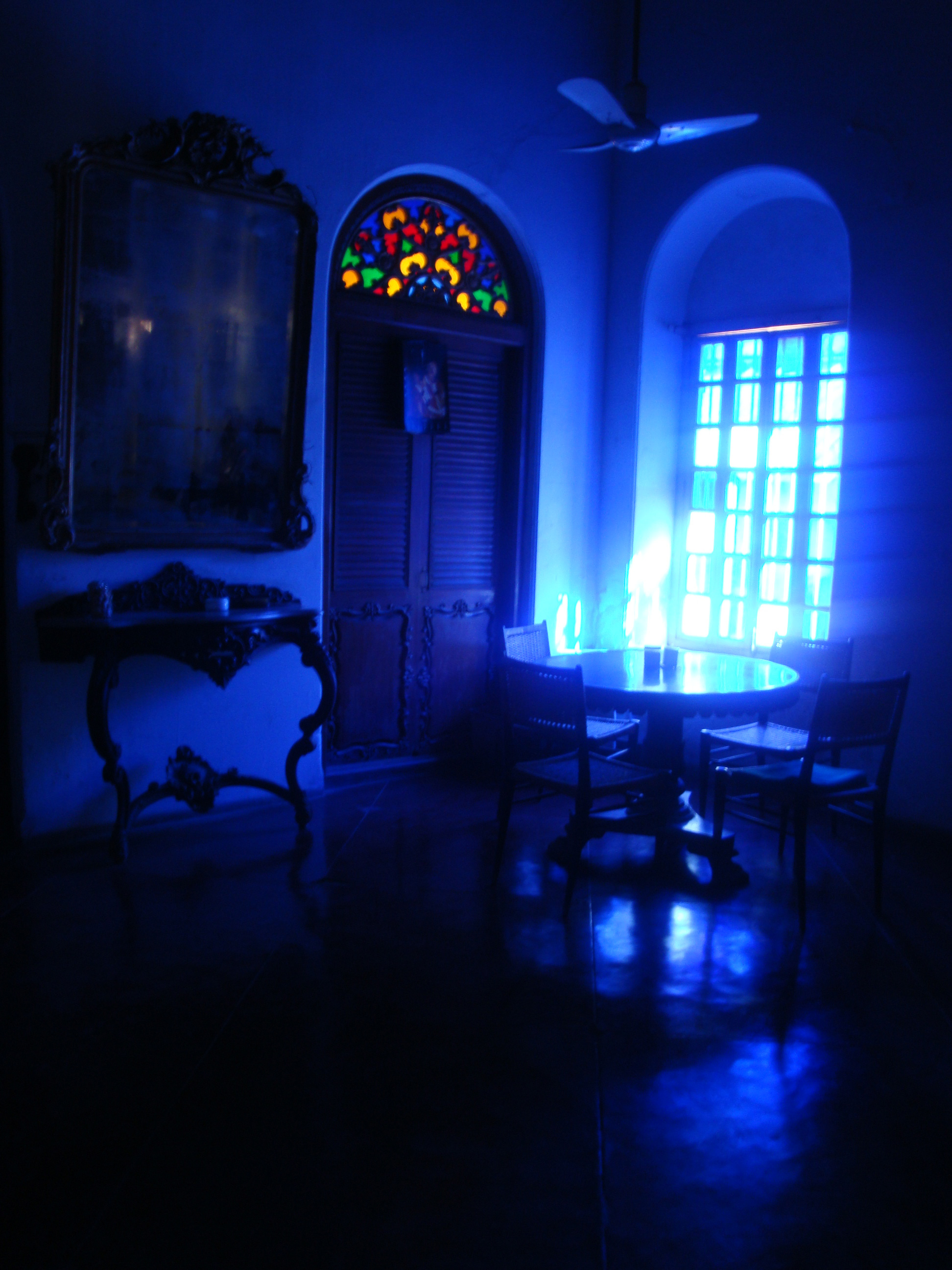
My favourite part of the place; The bathroom door is completely stained glass:
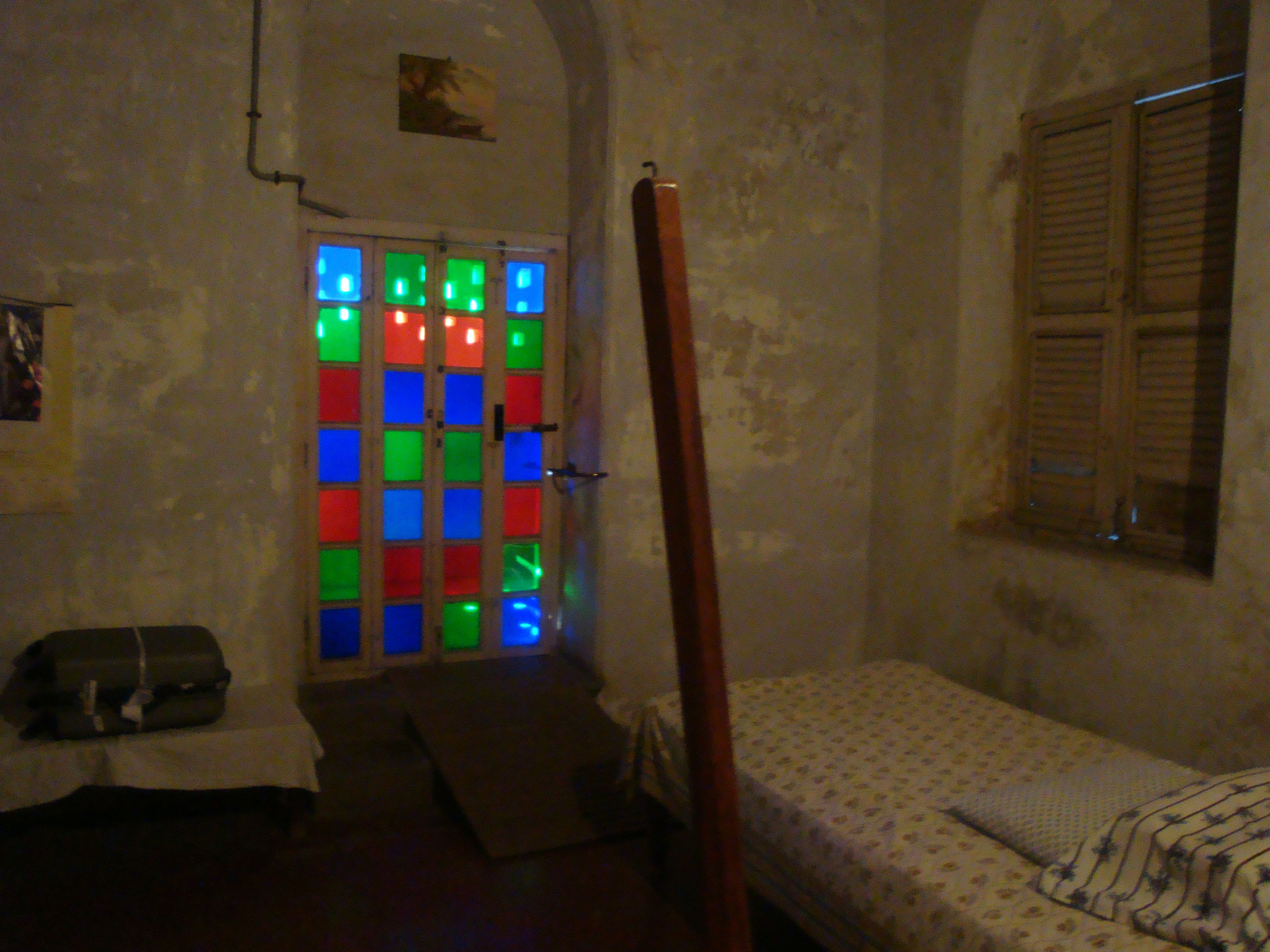
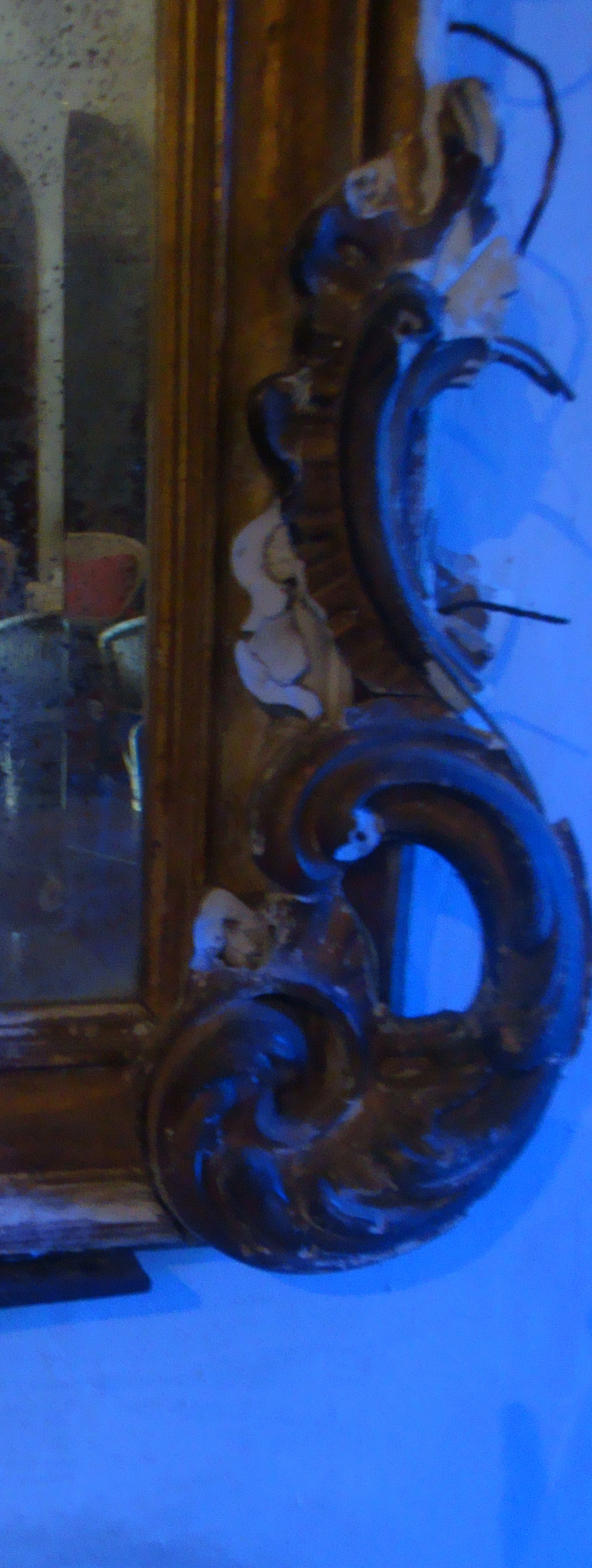 Detail of the giant mirrors on both sides of the drawing room.
Detail of the giant mirrors on both sides of the drawing room.
The stained glass windows really add to the overall effect, and conflict nicely with the traditional, and brightly painted carved wood and absence of glass on the ground floor:
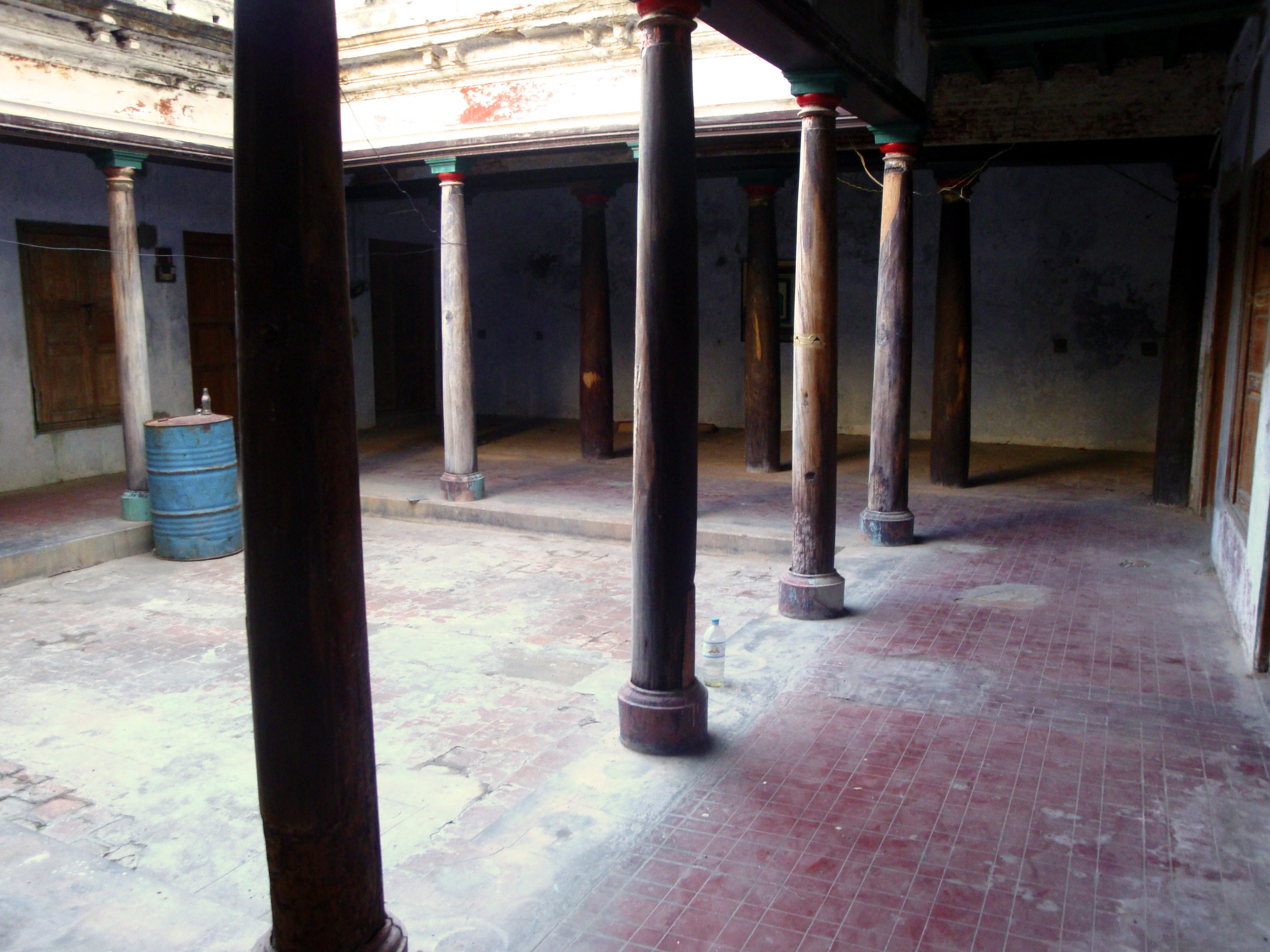
Only some of painted details remain, but these wooden columns were completely painted before falling into disrepair. Unfortunately, this part of the house has also not been maintained.
Here you can see an area where the bright colours are still visible and not completely faded:

Related Posts:















